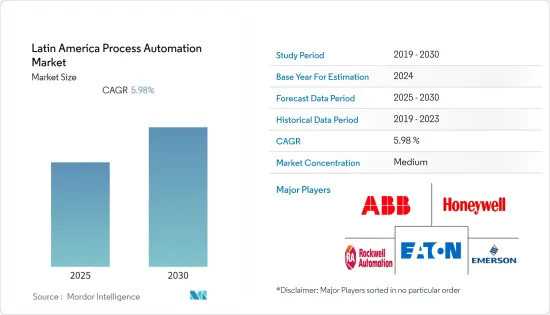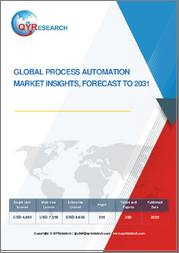
|
시장보고서
상품코드
1627126
라틴아메리카의 공정 자동화 : 시장 점유율 분석, 산업 동향 및 성장 예측(2025-2030년)Latin America Process Automation - Market Share Analysis, Industry Trends & Statistics, Growth Forecasts (2025 - 2030) |
||||||
■ 보고서에 따라 최신 정보로 업데이트하여 보내드립니다. 배송일정은 문의해 주시기 바랍니다.
중남미 공정 자동화 시장은 예측 기간 동안 CAGR 5.98%를 나타낼 것으로 예상됩니다.

주요 하이라이트
- 자동화는 현대의 제조 및 산업 공정에 필수적인 요소로 자리 잡았습니다. 기업이 위의 우선순위를 실현하는 데 도움이 되고 있습니다. 전 세계 기업들은 SCADA, DCS, MES, PLC 등 다양한 기술의 도움으로 업무를 자동화하고 있습니다. 이러한 기술에 대한 수요가 급증하고 있으며, 많은 벤더들이 기업의 제조 공정 효율화를 지원하는 솔루션을 생산하고 있습니다.
- IoT 수요 동향은 주로 다양한 인더스트리 4.0 용도에 의해 주도되고 있으며, 가까운 시일 내에 소비자 수요에서 산업 부문으로 전환될 것으로 예상됩니다. 멕시코나 브라질과 같은 국가들은 산업혁명을 앞두고 있으며, 데이터는 공급망 전반에 걸쳐 다양한 제조 시스템과 통합되어 생산에 대규모로 활용되고 있습니다.
- 또한, 빅데이터 분석을 통해 기업은 공장 자동화를 통해 반응적 관행에서 예측적 관행으로 전환할 수 있습니다. 이러한 변화는 프로세스 효율성과 제품 성능을 향상시키는 것을 목표로 합니다.
- 제조 공정의 자동화는 모니터링 용이성, 낭비 감소, 생산 속도 향상 등 다양한 이점을 제공합니다. 이 기술은 표준화를 통한 품질 향상과 고객에게 적시에 저렴한 비용으로 신뢰할 수 있는 제품을 제공합니다.
- 또한, 산업기계와 설비를 연결하고 실시간 데이터를 수집하는 것은 SCADA, HMI, PLC 시스템 및 시각화를 제공하는 소프트웨어의 채택에 중요한 역할을 하고 있습니다.
라틴아메리카 공정 자동화 시장 동향
제약산업이 큰 시장 점유율을 차지할 것으로 예상
- 제약 산업은 공중 보건 안전이 중요하기 때문에 규제가 엄격합니다. 정확성, 반복성 및 제어는 자동화 시스템의 주요 장점으로, 제약 제조 시설의 생산성, 안전 및 청결을 향상시키는 데 도움이 됩니다. 프로세스 최적화, 규제 준수 및 공급망 강화의 필요성이 제약 산업 전반에 걸쳐 자동화 기술에 대한 투자를 촉진하고 있습니다.
- 자동화는 원료의약품(API)과 같은 1차적 측면과 포장 및 유통을 포함한 기타 2차적 측면에 통합되어 있습니다. 디지털 전환은 이 지역 제약회사에 새로운 업무 효율성, 품질, 프로세스 자동화, 직원 생산성 향상을 가져다 줄 수 있습니다.
- 또한 제조, 검사, 의약품 개발, 포장, 유통 등 다양한 공정에 대한 공정 자동화 솔루션에 대한 수요 증가는 공정 자동화 및 계측 시장의 제약 산업 성장을 가속할 것으로 예상되는 요인 중 하나입니다.
- 자동화는 공정에 대한 더 나은 제어와 원격지에서 공정을 모니터링할 수 있는 능력을 설명합니다. 또한 자동화된 보고서 작성, 필요한 데이터 입력 및 실시간 정보 공유를 지원합니다. 자동화는 제품 개발, 상업적 생산 및 실시간 모니터링과 관련하여 제약업계에 변화를 가져오고 있습니다. 센서와 시스템을 도입하여 제조의 우수성을 촉진하고 기업이 최저 비용으로 컴플라이언스를 달성할 수 있도록 지원합니다.
- 또한, 라틴아메리카의 많은 제약 회사들은 직원들을 원격 근무에 동원하고 있습니다. 이러한 시나리오에서 자동화는 필수적인 프로세스를 방해받지 않고 계속 진행할 수 있도록 도와줍니다. 신약 개발의 자동화는 수작업으로 인한 실수를 최소화하고, 처리 용량을 늘리며, 재현성을 향상시켜 전체 프로세스의 신뢰성을 높입니다.
멕시코가 가장 큰 시장 점유율을 차지
- 중남미, 특히 멕시코의 IoT 솔루션은 공급망 프로세스에 대한 서비스 제공에서 의료, 관공서 및 접객업에 대한 가시성을 추가하는 것으로 성장하고 있으며, Wi-Fi, RFID, 블루투스, 센서의 급속한 보급은 IoT 혁명을 가져왔습니다. 가져왔습니다.
- 커넥티드 디바이스 및 웨어러블 디바이스에 대한 수요 증가도 국내 시장 성장을 견인하고 있습니다. 커넥티드 디바이스와 센서의 높은 채택률과 M2M 통신이 가능해짐에 따라 제조업에서 생성되는 데이터 포인트가 급증하고 있습니다.
- IoT 수요 동향은 주로 다양한 인더스트리 4.0 용도에 의해 주도되며, 가까운 미래에 소비자 수요에서 산업 부문으로 전환될 것으로 예상됩니다. 또한, 화학 및 석유화학, 제지 및 펄프, 물 및 폐수 처리, 에너지 및 유틸리티, 석유 및 가스, 제약, 식품 및 음료와 같은 공정 산업이 성장을 가속할 것으로 예상됩니다. 중남미 시장에서도 비슷한 추세가 나타났습니다.
- 멕시코의 스마트 공장에서 사이버 공격이 증가하면서 산업 제어 시스템 사용에 대한 우려가 커지고 있습니다. 정부는 이러한 범죄 증가를 억제하기 위한 계획을 세우고 있습니다. 이는 사이버 보안 침해의 위험을 피하기 위해 스마트 팩토리를 위해 국내에서 제조되는 산업 제어 시스템 증가 추세와 일치합니다.
- 또한, 프로세스 디스커버리, 프로세스 최적화, 프로세스 인텔리전스, 프로세스 오케스트레이션과 같은 기술과 용어는 로봇 프로세스 자동화(RPA)의 중요한 부분으로 자리 잡고 있습니다. 향후 비즈니스 프로세스 관리(BPM)와 RPA의 관계는 더욱 긴밀해질 것으로 보입니다.
라틴아메리카 공정 자동화 산업 개요
라틴아메리카의 공정 자동화 시장은 적당히 세분화되어 있으며, 신규 시장 진출기업이 적고, 지배적인 진입자도 적습니다. 각 업체들은 시장 점유율을 유지하기 위해 기술 혁신을 지속하고 전략적 파트너십을 체결하고 있습니다. 최근 시장 개척 동향은 다음과 같습니다.
- 2021년 7월 - Rockwell Automation, Inc는 클라우드 기반 제품 디지털화 및 추적성 플랫폼을 제공하는 Kezzler AS와 파트너십을 체결했다고 발표했습니다.
- 2020년 5월 - 무선 산업 자동화 및 IoT 솔루션 제공업체인 OleumTech는 새로운 지능형 압력 트랜스미터(HGPT 스마트 게이지 압력 트랜스미터)를 출시한다고 발표했습니다. 이 트랜스미터는 빠르게 성장하고 있는 H 시리즈 유선 공정 계측 제품군에 추가되는 제품으로, 석유화학, 화학, 전력, 석유 업스트림, 가스 폐수 등의 공정 산업에 이상적인 뛰어난 성능, 정확성 및 신뢰성을 제공한다고 밝혔습니다.
기타 혜택
- 엑셀 형식 시장 예측(ME) 시트
- 3개월간 애널리스트 지원
목차
제1장 서론
- 조사의 전제조건과 시장 정의
- 조사 범위
제2장 조사 방법론
제3장 주요 요약
제4장 시장 역학
- 시장 개요
- 산업 매력 - Porter의 Five Forces 분석
- 공급 기업의 교섭력
- 바이어의 교섭력
- 신규 진출업체의 위협
- 대체품의 위협
- 경쟁 기업간 경쟁 관계
- 산업 밸류체인 분석
- 시장 성장 촉진요인
- 시장이 해결해야 할 과제
- 산업 표준과 규제
제5장 COVID-19가 라틴아메리카 프로세스 자동화 산업에 미치는 영향 평가
- 팬데믹 단기·중기적 영향에 근거해 특정된 주요 테마 분석-V자 회복, 중기 회복, 슬럼프 회복
- 멕시코 프로세스 자동화 시장-최종사용자 실적에 의한 기반 변수 분석
- 브라질 프로세스 자동화 시장-최종사용자 실적에 의한 기반 변수 분석
- 아르헨티나 프로세스 자동화 시장-최종사용자 실적에 의한 기반 변수 분석
- 공급 관련 과제의 영향과 시장 활성화 시장 규제 역할
제6장 시장 세분화
- 통신 프로토콜별
- 유선
- 무선
- 시스템 유형별
- 시스템 하드웨어별
- 모니터링 제어 및 데이터 수집 시스템(SCADA)
- 분산형 제어 시스템(DCS)
- 프로그래머블 로직 컨트롤러(PLC)
- 제조 실행 시스템(MES)
- 밸브 및 액추에이터
- 전동 모터
- 휴먼 머신 인터페이스(HMI)
- 프로세스 안전 시스템
- 센서 및 트랜스미터
- 소프트웨어 유형별
- APC (Standalone & Customized Solutions)
- Advanced Regulatory Control
- Multivariable Model
- Inferential & Sequential
- Data Analytics and Reporting-based Software
- 기타 소프트웨어 및 서비스
- 시스템 하드웨어별
- 최종사용자 산업별
- 석유 및 가스
- 화학제품 및 석유화학제품
- 전력 및 유틸리티
- 상하수도
- 식품 및 음료
- 제지 및 펄프
- 제약
- 기타
- 국가별
- 멕시코
- 브라질
- 아르헨티나
- 기타 라틴아메리카 국가
제7장 경쟁 구도
- 기업 개요
- ABB Ltd
- Honeywell International Inc.
- Rockwell Automation
- Emerson Electric Co.
- Eaton Corporation
- Siemens AG
- Schneider Electric
- General Electric Co.
- Mitsubishi Electric
- Fuji Electric
- Delta Electronics Limited
- Yokogawa Electric
제8장 프로세스 자동화 산업의 주요 혁신기업와 과제 분석
제9장 투자 분석과 시장 전망
LSH 25.01.21The Latin America Process Automation Market is expected to register a CAGR of 5.98% during the forecast period.

Key Highlights
- Automation has become an essential part of modern manufacturing and industrial processes. It helps enterprises to realize the priorities above. Companies worldwide are automating their operations with the help of different technologies like SCADA, DCS, MES, and PLC. The demand for these technologies is escalating, and many vendors are manufacturing solutions to help enterprises achieve higher efficiency in their manufacturing processes.
- The IoT demand trend is expected to shift toward industrial space from consumer demand over the near future, primarily driven by various Industry 4.0 applications. Countries like Mexico and Brazil are on the verge of the industrial revolution, as data is being used on a large scale for production while integrating it with various manufacturing systems throughout the supply chain.
- Moreover, big data analytics allows an enterprise to use factory automation to shift from reactionary practices to predictive ones. This change targets to improve the efficiency of the process and performance of the product.
- Automation of manufacturing processes has offered various benefits, such as effortless monitoring, reduction of waste, and production speed. This technology offers customers an improved quality with standardization and dependable products within time and at a much lower cost.
- Further, connecting the industrial machinery and equipment and obtaining real-time data have played a vital role in the adoption of SCADA, HMI, PLC systems, and software that offer visualization; thus enables reducing the faults in the product, reducing downtime, scheduling maintenance, and switching from being in the reactive state to predictive and prescriptive stages for decision-making.
Latin America Process Automation Market Trends
Pharmaceutical Industry is Expected to Hold Significant Market Share
- The pharmaceutical industry is highly regulated due to the importance placed on public health safety. Accuracy, repeatability, and control are the key benefits of an automated system, helping to enhance productivity, safety, and cleanliness in pharmaceutical manufacturing facilities. The need for process optimization, regulatory compliance, and enhancements in the supply chain are driving investment in automation technologies across the pharmaceutical industry.
- Automation is embedded in primary aspects such as Active Pharma Ingredients (API) and other secondary aspects, including packaging and distribution. Digital transformation provides new operational efficiency, quality, process automation, and employee productivity to pharmaceutical companies in the region.
- Moreover, an increase in the need for process automation solutions to various processes such as manufacturing, testing, drug development, packaging, and distribution are among the factors that are likely to propel the growth in the pharmaceutical industry in the process automation and instrumentation market.
- Automation offers better control of processes and the ability to monitor processes from remote locations. It assists in automatically creating reports, entering essential data, and sharing real-time information. Automation is transforming pharma concerning product development, commercial production, and real-time monitoring. It can foster manufacturing excellence by adopting sensors and systems to help companies achieve compliance at the lowest costs.
- Further, many pharma companies in Latin America have mobilized their employees to remote working conditions. In such a scenario, automation helps them continue the essential processes unobstructed. Automation in drug discovery enhances the reliability of the entire process by minimizing manual errors, augments the throughput, and improves the ability to reproduce.
Mexico Accounts for the Largest Market Share
- IoT solutions in Latin America, specifically Mexico, have grown from servicing the supply chain process to adding visibility to healthcare, government offices, and hospitality industries. The rapidly growing implementation of Wi-Fi, RFID, Bluetooth, and sensors have brought on the IoT revolution, which is believed to be the most transformative technology for the next decade by 99% of respondents.
- The increasing demand for connected and wearables devices is also aiding the growth of the market in the country. With the high rate of adoption of connected devices and sensors and the enabling of M2M communication, there has been a surge in the data points generated in the manufacturing industry.
- The IoT demand trend is expected to shift toward industrial space from consumer demand over the near future, primarily driven by various Industry 4.0 applications. Furthermore, process industries, such as chemical and petrochemical, paper and pulp, water and wastewater treatment, energy and utilities, oil and gas, pharmaceutical, food, and beverages, are expected to fuel growth. Similar trends were observed in the Latin American market as well.
- With cyber-attacks increasing in smart factories in Mexico, there is growing concern about using Industrial Control Systems. The government has plans to curb the rise of such crimes. This aligns with the growing trend of industrial control systems manufactured in the country for smart factories to avoid the risk of cybersecurity breaches.
- Further, technologies and terminologies such as process discovery, process optimization, process intelligence, and process orchestration are becoming a more significant part of Robotic Process Automation (RPA). There is an ongoing trend of increasing a closer relationship between business process management (BPM) and RPA in the future.
Latin America Process Automation Industry Overview
The Latin American Process Automation Market is moderately fragmented, with few new entrants and few dominant players. The companies keep on innovating and entering into strategic partnerships to retain their market share. Some of the recent developments in the market are:
- July 2021 - Rockwell Automation, Inc announced a partnership with Kezzler AS, cloud-based product digitization and traceability platform, to help manufacturers capture the journey of their products from raw material sources to point-of-sale or beyond using cloud-based supply chain solutions that focus on product traceability.
- May 2020 - OleumTech, wireless industrial automation and IoT solutions provider announced the launch of new intelligent pressure transmitters (HGPT Smart Gauge Pressure Transmitters). These transmitters are an addition to its fast-growing H Series line of hardwired process instrumentation and claimed to deliver remarkable performance, accuracy, and reliability ideal for process industries, such as petrochemical, chemical, power, upstream oil, and gas wastewater.
Additional Benefits:
- The market estimate (ME) sheet in Excel format
- 3 months of analyst support
TABLE OF CONTENTS
1 INTRODUCTION
- 1.1 Study Assumptions and Market Definition
- 1.2 Scope of the Study
2 RESEARCH METHADOLOGY
3 EXECUTIVE SUMMARY
4 MARKET DYNAMICS
- 4.1 Market Overview
- 4.2 Industry Attractiveness - Porter's Five Forces Analysis
- 4.2.1 Bargaining Power of Suppliers
- 4.2.2 Bargaining Power of Buyers
- 4.2.3 Threat of New Entrants
- 4.2.4 Threat of Substitutes
- 4.2.5 Intensity of Competitive Rivalry
- 4.3 Industry Value Chain Analysis
- 4.4 Market Drivers (Growing emphasis on energy efficiency & cost reduction| Demand for Safety Automation Systems| Emergence of IIoT)
- 4.5 Market Challenges (Cost & Implementation Challenges)
- 4.6 Industry Standards & Regulations
- 4.7 Analysis of the major Industrial Automation hubs in the Mexico, Brazil, and Argentina - To be identified based on the investor activity & expansion activities undertaken over the last 3 years
5 ASSESSMENT OF THE IMPACT OF COVID-19 ON THE PROCESS AUTOMATION INDUSTRY IN LATIN AMERICA
- 5.1 Analysis of the key themes identified based on the near & medium-term effects of the pandemic - V-shaped recovery, Mid-range recovery & Slump recovery
- 5.2 Mexico Process Automation Market - Base variable analysis based on end-user performance
- 5.3 Brazil Process Automation Market - Base variable analysis based on end-user performance
- 5.4 Argentina Process Automation Market - Base variable analysis based on end-user performance
- 5.5 Impact of Supply-related challenges & the role of market regulations in spurring activity
6 MARKET SEGMENTATION
- 6.1 By Communication Protocol
- 6.1.1 Wired
- 6.1.2 Wireless
- 6.2 By System Type
- 6.2.1 By System Hardware
- 6.2.1.1 Supervisory Control and Data Acquisition System (SCADA)
- 6.2.1.2 Distributed Control System (DCS)
- 6.2.1.3 Programmable Logic Controller (PLC)
- 6.2.1.4 Manufacturing Execution System (MES)
- 6.2.1.5 Valves & Actuators
- 6.2.1.6 Electric Motors
- 6.2.1.7 Human Machine Interface (HMI)
- 6.2.1.8 Process Safety Systems
- 6.2.1.9 Sensors and Transmitters
- 6.2.2 By Software Type
- 6.2.2.1 APC (Standalone & Customized Solutions)
- 6.2.2.1.1 Advanced Regulatory Control
- 6.2.2.1.2 Multivariable Model
- 6.2.2.1.3 Inferential & Sequential
- 6.2.2.2 Data Analytics and Reporting-based Software
- 6.2.2.3 Other Software and Services
- 6.2.1 By System Hardware
- 6.3 By End-user Industry
- 6.3.1 Oil and Gas
- 6.3.2 Chemical and Petrochemical
- 6.3.3 Power and Utilities
- 6.3.4 Water and Wastewater
- 6.3.5 Food and Beverage
- 6.3.6 Paper and Pulp
- 6.3.7 Pharmaceutical
- 6.3.8 Other End-user Industries
- 6.4 By Country
- 6.4.1 Mexico
- 6.4.2 Brazil
- 6.4.3 Argentina
- 6.4.4 Rest of the Latin America
7 COMPETITIVE LANDSCAPE
- 7.1 Company Profiles
- 7.1.1 ABB Ltd
- 7.1.2 Honeywell International Inc.
- 7.1.3 Rockwell Automation
- 7.1.4 Emerson Electric Co.
- 7.1.5 Eaton Corporation
- 7.1.6 Siemens AG
- 7.1.7 Schneider Electric
- 7.1.8 General Electric Co.
- 7.1.9 Mitsubishi Electric
- 7.1.10 Fuji Electric
- 7.1.11 Delta Electronics Limited
- 7.1.12 Yokogawa Electric
8 ANALYSIS OF MAJOR INNOVATORS & CHALLENGERS IN THE PROCESS AUTOMATION INDUSTRY
9 INVESTMENT ANALYSIS & MARKET OUTLOOK
샘플 요청 목록



















